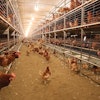While table egg prices and profits have been strong since last fall, that’s about the change in the post-Easter period. Over the past 20 years, there have only been two profitable months, on average, from Easter to Labor Day, says Wayne Mooney, vice president of egg sales and marketing for Pilgrim’s Pride Corp., Dallas.
Traditionally, egg prices fall 20 cents post-Easter, which this year would put prices at about 85 cents per dozen. Demand that can exceed 150 percent of normal just prior to Easter “goes down drastically” following Easter, Mooney says.
In Mooney’s view, the industry must reduce bird numbers to have a chance at profits in post-Easter months. In a conversation last week with members of the United States Egg Marketers—representing 30 percent of U.S. egg production—all said they were reducing the size of their flocks, Mooney says, adding that Pilgrim’s Pride is doing the same. It looks to him like the nation’s flock needs to come down by 10 percent for the industry to have a good shot at profits in some months between now and the rest of the year.
One optimistic point, he says, is that the world is in need of a higher supply of eggs right now, and he’s hopeful that translates into additional export orders. Export orders since last fall have helped boost prices.
Mooney adds, however, that “there will be no profit if we don’t get the bird population taken care of.”
One thing that makes this year different, says Mooney, who also is the chairman of the American Egg Board’s executive committee, “are extremely high feed prices” that are adding 10 to 12 cents in additional costs to produce a dozen eggs than was the case last July and August.
He also says that “we can’t depend on breakers” to take excess production from table egg producers like in the past “because they’re producing their own.”


.jpg?auto=format%2Ccompress&fit=crop&h=167&q=70&w=250)














